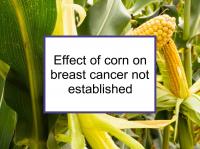Sweet yellow corn (Zea mays var. saccharata) is a good source of zeaxanthin, thiamin (vitamin B1) and pantothenic acid (vitamin B5) and also incorporates other B vitamins. Corn can also incorporate meaningful amounts of alpha-carotene, beta-carotene, beta-cryptoxanthin, campesterol, ferulic acid, insoluble fiber, lutein and melatonin.
Breast cancer-related effects of eating corn
Corn and corn products
There is little available information concerning the relationship between the consumption of fresh corn, cornmeal, cornstarch or grits and breast cancer risk. Generally speaking, white corn incorporates less beneficial nutrients than yellow corn.
Corn and foods made from corn have a high glycemic index. Cornmeal, cornstarch and grits do not appear to promote breast cancer directly. However, one study found a link between increased starch intake after a diagnosis of early stage breast cancer and increased risk of recurrence. Corn oil is covered in a separate webpage.
Beneficial corn compounds
Sweet corn contains some melatonin, whereas maize or field corn (used to make corn tortillas, corn chips and masa) can have higher levels. Melatonin protects against ER+ breast cancer by reducing aromatase activity within the breast, thereby decreasing estrogen production. Melatonin has also been found to reduce triple negative (ER-/PR-/HER2-) breast cancer growth, proliferation and migration in cell and animal studies. In addition, melatonin has been shown to reduce the cardiotoxicity associated with doxorubicin chemotherapy.
Ferulic acid, which is more abundant in yellow corn than white corn, has been reported to induce programmed cell death in triple negative breast cancer cells. Ferulic acid has also been shown to synergistically enhance the treatment effects of doxorubicin, paclitaxel, epirubicin and tamoxifen. In addition, ferulic acid has been demonstrated to reduce the heart damage caused by doxorubicin in an animal study of doxorubicin-induced cardiomyopathy. Sweet corn and maize both contain zeaxanthin and lutein, which have been shown to have chemopreventive properties.
Purple and blue corn
Purple and blue corn are abundant sources of anthocyanins (primarily cyanidin-3-glucoside). The darker the corn, the higher the level of anthocyanins. Such corn anthocyanins have been shown to have potent antioxidant, anti-inflammatory, antimutagenic, anticarcinogenic, and anti-angiogenic properties. Blue corn and blue corn tortilla extracts have been shown to have antiproliferative effects against hormone receptor positive (ER+/PR+) and triple negative breast cancer cells.
High fructose corn syrup
High fructose corn syrup is a sweetener manufactured from cornmeal which is found in a wide variety of processed foods, for example, candy bars, packaged pastries, ketchup, ice cream, soda, and juice drinks. Diets elevated in high fructose corn syrup have been linked to chronic inflammation, a breast cancer risk factor, as well as increased risk of triple negative breast cancer. High fructose corn syrup has also been reported to worsen the cardiotoxicity induced by combined anthracycline chemotherapy and HER2-blocking agents such as trastuzumab.
Breast cancer cell metabolism is characterized by enhanced uptake and use of glucose. Fructose normally is barely metabolized in breast cancer cells. However, it has been demonstrated that when glucose is not available (i.e., the cells are in a state of glucose deficiency), fructose can be used instead by breast cancer cells. In addition, a 2024 study reported that the liver converts fructose into usable nutrients for cancer cells. These results suggest that a diet abundant in high fructose corn syrup could promote the progression of breast cancer.
Additional comments
Zearalenone and corn products
Corn is widely contaminated by zearalenone, a mycoestrogen that is produced by several species of fusarium fungi and shares similar molecular mechanisms and activity with mammalian estrogens. One 2025 study found that zearalenone at levels found in the food supply can promote ER+ breast cancer. Another 2025 study reported that zearalenone and its metabolite α-zearalenol were able to interfere with the treatment effects of doxorubicin in ER+/PR+ breast cancer cells.
Functional fiber products
Fiber is added to some processed foods in order to qualify the foods as “high fiber” or to improve texture. This isolated or functional fiber is extracted or synthesized from plant sources. Examples include soluble corn fiber (from corn), inulin (chicory root or sugar beets), cellulose (wood pulp), maltodextrin (corn, rice, or potato starch) and polydextrose (corn starch). Such fiber-fortified foods typically lack the flavonoids and other biologically active components of the foods from which they are derived and may lack nutritional value, however there is no evidence that functional fiber is harmful.
Sources of information provided in this webpage
The information above, which is updated continually as new research becomes available, has been developed based solely on the results of academic studies. Clicking on any of the underlined terms will take you to its tag or webpage, which contain more extensive information.
Below are links to 20 recent studies concerning this food and its components. For a more complete list, including less recent studies, please click on corn.
